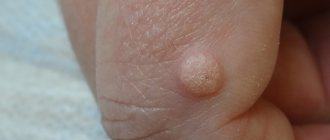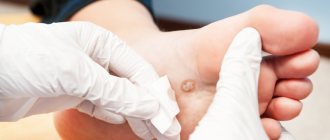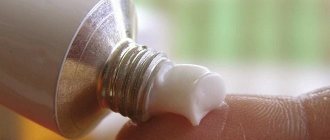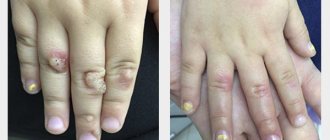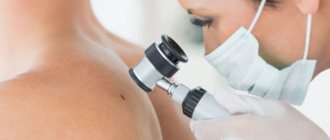Benign growths that appear on the body as a result of exposure to the human papillomavirus (HPV) are called warts. They are neoplasms in the epidermis. Basically, warts on the skin are divided into types according to the type of HPV that caused the appearance on the skin. There are more than 200 genotypes of the virus. It affects not only humans; warts are also found in mammals and some species of birds. Very often, the virus is transmitted to humans from an infected animal. The most common HPV viruses include genotypes 2, 27, 57, 4 and 1. Below we will look at how to diagnose and remove warts, as well as avoid their appearance.
general information
A common wart is a growth on the skin that has a rough surface and protrudes to a certain height above the surface of the epidermis. The color of warts is lighter or darker than the surrounding tissues; on large formations, internal vessels can be seen. The main cause of warts is infection with the human papillomavirus. HPV enters the body through damaged or water-soaked skin. Sometimes infection is possible even if there is no damage to the body. The difficulty of identifying the cause of infection is due to the fact that some warts in adults appear on the body only six months after infection.
HPV mainly affects children and young people. Patients who have a history of chronic skin diseases are susceptible to the problem:
- Psoriasis;
- Dermatitis;
- Eczema, etc.
Patients who have a weakened immune system are also at risk. We are mainly talking about people infected with HIV or those who have undergone organ transplantation. If a patient has problems with immunity, treatment difficulties may arise in the future. In this case, a viral wart most often recurs after removal.
Warts can be found on the skin anywhere on the body. Moreover, most often they are localized in the area of the fingers, elbows, knees, and hands.
How to distinguish a papilloma from a mole
The papilloma is colorless and pedunculated.
A nevus or wart does not have a stalk and is brown in color.
It is advisable to remove papillomas, since they are most often located in areas of increased trauma and are not very aesthetic.
As a rule, moles do not pose any danger.
They do not have a special function and in their structure contain various pigments in large quantities.
Types of warts
There are several types of formations. Basically, the division into types of warts is associated with the external aspect, the cause of occurrence and other factors. The following types of warts are distinguished:
- Ordinary (vulgar)
. This type of formation is characterized by an age limitation - predominantly the problem caused by HPV develops in childhood. Warts on the hands, fingers and toes are a common location for the problem. What a wart looks like - a colorless lump the size of a pin's head. Sometimes larger formations are possible. A viral wart rarely manifests itself as a single rash; most often you can find a whole scattering of neoplasms in the affected area. An interesting fact is that if the largest wart in the affected area is correctly removed surgically, the rest will disappear on their own over time. - Flat
. These types of warts mostly appear between the ages of 10 and 25. They are small papules that practically do not stand out above the skin. The surface of the wart is colorless, in some cases the skin in the affected areas acquires a yellowish tint. Viral warts most often appear on the back of the hand, hands, neck and face. - Plantar
. Most often, people with this problem have the question of how to get rid of warts. This is due to the fact that the rashes cause discomfort and pain, especially while walking. They mainly occur on the feet in places that experience excessive friction when walking. The main problem of such a neoplasm is difficulty in self-identification due to its appearance, which is very similar to ordinary plantar calluses. - Seborrheic
. The types of warts in this category are diagnosed in elderly patients. A distinctive feature of education is long-term formation, sometimes it takes several years. Appears as a dark brown small spot on the body, which gradually increases in size, eventually reaching a diameter of 5-6 centimeters. Warts are characterized by the presence of a greasy surface with crusts. Over time, the formation thickens, becomes covered with cracks and darkens significantly. Senile warts occur on closed areas of the body. - Condylomas
. It has a specific place of occurrence - in the area of the perineum and genitals. Warts can also be found in the armpits, under the breasts in women, and in the area of the nasolabial triangle in children. They got their name due to their pointed and lobed structure. Such warts are characterized by multiple distribution in the affected area - the rash is never isolated. The color of the new growth is colorless or pale pink. In some cases, warts begin to rub against clothing or other objects, eventually become damaged, become purple in color, and begin to bleed.
Causes of warts
A question that worries even those who have not encountered this: why do warts appear? The main method of infection is contact. If you come into contact with a person who already has HPV in their body, there is a high probability that it will be transmitted to you, especially if there are associated factors. The main method of transmission is through handshakes. You can also become infected through common household items, such as bed linen, towels, slippers, etc. There is a high risk of catching the virus in public places - in swimming pools, baths, gyms, etc.
The risk of contracting warts increases under the influence of various unfavorable factors
:
- There are small injured areas on the arms and legs. People who do physical labor at work are at risk. It is extremely difficult for such employees to keep their hands from injury while performing work tasks. Cracks, scratches, and cuts appear on the hands, through which HPV can easily penetrate.
- Decreased protective immune functions of the body. You can determine the problem yourself. Just keep track of how often you get colds throughout the year. An indicator of 4 times or more should cause concern.
- Violent sweating in the hands and feet.
These factors make it easier for the papilloma virus to enter the patient’s body and cause the appearance of warts. The infection is characterized by a long incubation period - the first rash in some cases appears only 1.5 months after infection.
conclusions
Liquid warts can cause discomfort to a person and also look unsightly, especially on open areas of the body. Therefore, to remove them, you need to contact a dermatologist who will conduct the necessary research and determine the safest and most effective way to get rid of warts. The sooner a person consults a doctor, the less likely it is that warts will reappear.
ONLINE REGISTRATION at the DIANA clinic
You can sign up by calling the toll-free phone number 8-800-707-15-60 or filling out the contact form. In this case, we will contact you ourselves.
Symptoms
The types of warts also affect the symptoms experienced by an infected patient. Moreover, all types of formations are characterized by a list of identical symptoms:
- The appearance of single or multiple neoplasms. Warts can appear not only on the skin. A rash on the mucous membranes is also possible.
- When pressing on the surface of the formation, painful sensations occur.
- The nail plate becomes deformed, and the periungual fold grows in the affected area.
- Deformation of the feet in case of massive lesions, severe pain.
Types of warts and specific symptoms:
- Molluscum contagiosum
. Localization - on the body or in the genital area. There are depressed areas on the surface. If you press on the wart, a mushy substance may begin to ooze. - Nevi
. May be a congenital problem, raised significantly above the surface of the skin. Characterized by a dark brown color, as well as the presence of hair. - Basalioma
. It has a crust on the surface; if it is removed intentionally or accidentally, bleeding begins.
Diagnostics
The differential diagnosis is based on the clinical picture of the specific type of neoplasm, as well as on the study of the anamnesis. The size of the papule, the rate at which it increases in size, the number of formations and other factors are taken into account.
To make a final diagnosis, the patient may be referred for histological examination.
If the appearance of warts is planned to be excluded using destructive methods, it is first important to be tested for HIV, hepatitis and syphilis.
Complications of papillomas
The most important complication is the degeneration of benign neoplasms into malignant tumors.
It is necessary to determine as quickly as possible the type of HPV that caused the formation of papillomas.
If it is a highly oncogenic type 16 or 18, constantly monitor the development and changes in the condition of papillomas.
These pedunculated papillomas also threaten traumatization and relapse.
You should always remember this and avoid injury, and after removing papillomas, prevent their occurrence.
Treatment methods for warts
Treatment of warts does not guarantee 100% results. Even a healed wart may reappear in the future. Removal of warts only in 70% of cases does not result in relapse after a while. The behavior of warts is unpredictable. Treatment of warts may often not bring any results, and in some cases the problem resolves on its own without any intervention at all.
Treatment of warts has two goals - destruction of the viral tumor, improving the quality of life for the patient. Indications for starting treatment are the clinical manifestation of the problem. The most common method is based on the destruction of education. However, there is no guarantee that after complete healing of the tissue in the affected area, the problem will not reappear. Most often, relapses are typical for neoplasms of a large area - from two centimeters. Warts on the fingers and in the area of the periungual plate are also considered problematic.
Warts are treated using several methods. The choice of a specific method for treating warts directly depends on the type of lesion, its prevalence, location and other factors. All interventions are carried out without mandatory hospitalization of patients.
Treatment of warts with physical destructive methods
- Electrocoagulation
. The affected area is numbed, then an electric current is applied to the wart using a needle tip. The method allows you to remove the wart layer by layer. - Cryodestruction
. Freezing the surface of the tumor using liquid nitrogen. The duration of exposure is from 1 to 5 minutes. A repeat procedure is required a week after the first. - Laser exposure
. Depending on the size of the wart, laser contact on the area lasts from a few seconds to 2-3 minutes. The crust formed on the surface is cut with scissors, then the bottom of the wart is re-exposed using a laser. The disadvantage of this method is that a wound surface is formed, which the patient needs to treat independently. The affected area should not be re-injured, and it is also important to avoid getting wet. The scab that appears on the surface is removed by the patient. - Radiosurgery
. The affected area is exposed to electromagnetic waves. As a result of this effect, the surface of the wart is dissected without mechanical force. The intervention is carried out with local anesthesia of the affected area. Most often, a 2% lidocaine solution is administered.
Treatment of warts with chemical methods
- Zinc solution. Before removing the wart, the doctor treats the surface with alcohol to disinfect and facilitate penetration of the composition. The solution is applied using a spatula or capillary, it all depends on the size of the wart. The duration of application is until the neoplasm changes its color. The procedure is repeated after 1-2 weeks. For ordinary warts, 1-2 procedures are most often sufficient; if we are talking about plantar warts, applying the solution may require three times. The wart tissue undergoes mummification under the influence of the composition, in order to increase the effectiveness of the effect; dead areas are removed before new application. During the periods between procedures, the patient is not recommended to wet the area. The surface is also subjected to antiseptic treatment using alcohol-free compounds.
- Composition based on nitric, acetic, oxalic, lactic acid and sodium nitrate trihydrate. In this method, the surface of the wart is also pre-degreased. It is important to apply the composition exclusively to the affected areas, without touching healthy tissue. The product turns tumors on the skin yellow and on mucous membranes white. The patient is required to return for an examination 3-5 days after treatment. The method is not suitable for warts that exceed 5 centimeters in diameter.
How to remove warts in childhood? Treatment is possible only with the help of destructive methods in order to avoid possible toxic effects on a fragile organism.
It is important to remember that it is easier to prevent the appearance of warts than to subsequently treat them in a clinic. There are several rules of prevention:
- Maintain personal hygiene, wash hands after visiting public places, use only personal items.
- If damage appears on the skin of the hands or feet, they must be treated with iodine or brilliant green until they heal. It is also advisable to limit contact with HPV carriers.
- Normalization of nutrition. The body must receive all the elements necessary for the normal development of the body. It is also important to remove stress from your daily life as much as possible.
Degeneration of papillomas into malignant pathology
We must always remember that HPV poses a risk of cancer.
Especially highly oncogenic types, for example, 16 and 18.
Typically, malignant degeneration of papillomas cells takes ten to twenty years from the moment of infection.
The process is accelerated by smoking, drinking alcohol, obesity and hormonal disorders that reduce immunity.
It is the decrease in immunity, which occurs for various reasons, that contributes to the activation of HPV and the transition of the benign state of papillomas to a malignant pathology.
The destruction of papillomas is enhanced by cytomegalovirus, genital herpes, chlamydia, syphilis, gonorrhea, and trichomoniasis.
And of course, you need to avoid frequent trauma to papillomas, which contributes to their malignancy.
A direct indication for removal of papillomas is the presence of large papillomas.
They are often hurt and hurt.

